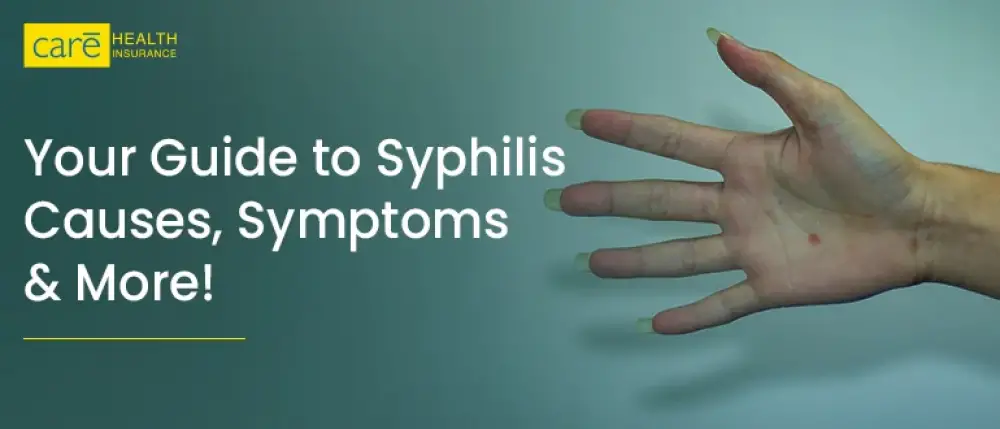Subscribe to get weekly insights
Always stay up to date with our newest articles sent direct to your inbox
Published on 21 Nov, 2024
Updated on 15 Apr, 2025
464 Views
3 min Read

Written by Jyotsana Shekhawat
1Like
Syphilis is a common yet—more often than not—overlooked health concern. It is a sexually transmitted infection (STI) caused by Treponema pallidum (a bacterium) and can result in serious health consequences when left unattended. The disease is also called “The Great Pretender” due to Syphilis symptoms that are known for mimicking several other diseases, making proactive treatment a must.
The foundation for all Syphilis causes is set by the bacteria called Treponema pallidum. It enters the body typically during sexual contact, marking its way through abrasions or small cuts on the skin or mucous membranes. Here are the common Syphilis causes or the ways this bacteria spreads in the body:
While these are the primary Syphilis causes, it is just as important to note that the disease is not transmitted through casual contact like sharing food, holding hands, hugging or using the same toilet seats.
Syphilis progresses in four stages, namely: primary, secondary, latent and tertiary. It is crucial to keep in mind that Syphilis symptoms vary from stage to stage—and can also appear distinctly. Let’s understand each one of the stages and the symptoms associated with it.
This is the first stage of syphilis, where the infection starts establishing itself in the body. The initial syphilis symptoms include a single, painless sore (known as chancre) on genitals, anus or mouth. This sore is often painless and one might mistake the same for a pimple.
In the secondary stage, the syphilis symptoms are more visible and noticeable as the infection starts spreading throughout the body. Here’s what it can lead to:
The latent stage is often hidden, with no syphilis symptoms in sight; however, the bacteria is still there in the body and it can potentially give rise to complications in the future.
The last and the most severe stage is called tertiary, which occurs years after the initial infection when left untreated. The syphilis symptoms during this stage are a bit too critical, and include:
Early diagnosis of syphilis symptoms can help prevent long-term complications. Here’s what Syphilis diagnosis looks like:
Syphilis symptoms can be treated effectively with the help of antibiotics. Here’s what syphilis treatment involves:
Note, individuals that are allergic to penicillin may be prescribed alternative antibiotics. Doctor consultation is advisable for syphilis treatment at any stage.
Avoiding syphilis causes at all costs is the best way to manage the disease! Here are some practices that you can adopt to maintain distance with bacteria Treponema pallidum:
By keeping these little things in mind, you can prevent Syphilis causes for good.
>>Read More: Vertigo: Causes, Symptoms, and Treatment
There are two aspects to understanding Syphilis meaning: a) You acknowledge that it is a serious condition; b) You rest assured that it is preventreatable. While being mindful during sexual contact and routine checkups can lower the scope for bacteria Treponema pallidum to be transmitted, timely RPR and VDRL screening can help eliminate Syphilis causes.
For added peace of mind through health conditions and treatment, keeping health insurance plays out to be a major deal. A comprehensive health insurance plan ensures you access the best treatment–right from diagnosis to medication–and burn no hole in your pocket too. And for the rest, keeping a check on a healthy lifestyle is the key.
Disclaimer: The above information is for reference purposes only. Kindly consult your general physician for verified medical advice. The health insurance benefits are subject to policy terms and conditions. Refer to your policy documents for more information.
शुगर कंट्रोल कैसे करे? जानें, डायबिटीज में क्या खाना चाहिए Care Health Insurance in Health & Wellness
Thyroid : मामूली नहीं हैं महिलाओं में थायराइड होना, जानें इसके लक्षण और घरेलू उपचार Care Health Insurance in Diseases
हाई ब्लड प्रेशर को तुरंत कंट्रोल कैसे करें? देखें इसके उपाय Care Health Insurance in Diseases
प्लेटलेट्स की कमी के लक्षण, कारण और इलाज क्या है Care Health Insurance in Diseases
What is Endocrinology? Hormones, Disorders & Treatment Care Health Insurance in Diseases
Do People with Mental Illness Have Less Heart Disease? Care Health Insurance in Diseases
एक्जिमा क्या है? देखें, इसके लक्षण और इलाज Care Health Insurance in Diseases
Guillain-Barré Syndrome (GBS): Causes, Symptoms and Treatment Care Health Insurance in Diseases